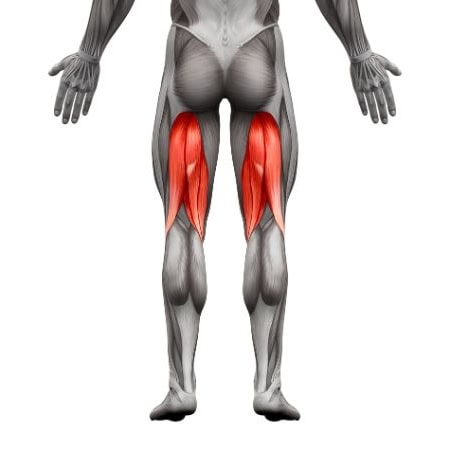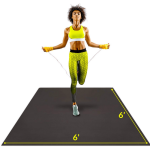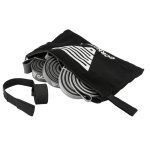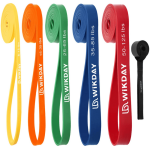Lying Hamstring Curls with Resistance Band
How to do Lying Hamstring Curls with Resistance Band?
Lying hamstring curls with a resistance band are an effective lower-body exercise targeting the hamstrings. In this movement, you lie face down with a resistance band anchored to a stable point and looped around your ankles. By curling your heels toward your glutes, you work against the band’s resistance to engage and strengthen the hamstrings. This exercise is an excellent alternative to machine hamstring curls, making it accessible for home workouts and useful for improving hamstring strength, knee stability, and lower-body balance.
Steps to Perform a Proper Lying Hamstring Curl with Resistance Band:
1. Anchor the Resistance Band:
• Secure a resistance band to a stable anchor point (such as a door anchor or heavy object) at floor level behind you.
• Lie face down on a mat, with your legs extended and your feet close to the anchor point.
2. Loop the Band Around Your Ankles:
• Place the ends of the band around your ankles or hook it securely. Adjust your position so there’s slight tension in the band when your legs are fully extended.
3. Engage Your Core and Prepare for the Curl:
• Keep your core tight by pulling your belly button toward your spine to stabilize your torso and lower back.
• Your head should rest in a neutral position, facing down, and your arms can be by your sides or bent at your elbows for support.
4. Curl Your Heels Toward Your Glutes:
• Exhale as you bend your knees, curling your heels up toward your glutes. Focus on squeezing your hamstrings throughout the movement.
• Keep your thighs and hips on the ground, preventing your lower back from arching.
5. Return to the Starting Position:
• Inhale as you slowly extend your legs back to the starting position, keeping tension in the band to control the movement.
• Stop just before your legs are fully straight to keep constant tension on the hamstrings.
6. Repeat the Movement:
• Perform the desired number of repetitions, maintaining control and tension in the band throughout each rep.
Benefits of Lying Hamstring Curls with Resistance Band
• Strengthens the Hamstrings: This exercise directly targets the hamstrings, helping to build strength and endurance in the posterior thigh muscles, which are essential for athletic performance.
• Improves Knee Stability: Strong hamstrings play a vital role in knee stability and injury prevention, especially in activities that require sudden starts, stops, or changes in direction.
• Enhances Glute Activation: By engaging the glutes to stabilize the hips, lying hamstring curls help improve overall glute strength and hip stability.
• Portable and Versatile: Resistance bands are lightweight and portable, making this exercise easy to perform at home, in the gym, or while traveling.
• Provides an Alternative to Machine Curls: For those without access to a hamstring curl machine, resistance band curls are a convenient alternative that allows for a similar movement and muscle engagement.
• Low-Impact on Joints: This exercise is gentle on the joints, making it suitable for individuals recovering from knee or hip injuries who still want to strengthen their lower body.
• Improves Functional Strength: Strong hamstrings contribute to better performance in various functional movements, such as running, jumping, and lifting, while also improving balance and stability.
Common Mistakes to Avoid
• Arching the Lower Back: Avoid lifting your hips or arching your lower back as you curl. Keep your core engaged and your torso stable throughout the exercise.
• Locking Out the Knees: Don’t fully straighten your legs at the bottom of the curl, as this can reduce tension on the hamstrings. Keep a slight bend in your knees to maintain constant tension.
• Using Momentum: Focus on slow, controlled movements rather than using momentum to swing your legs up. Using momentum decreases muscle engagement and increases the risk of strain.
• Inconsistent Tension: Ensure that the resistance band remains under consistent tension throughout the movement. Adjust your position if needed to prevent slack in the band.
• Poor Anchoring of the Band: Make sure the resistance band is securely anchored before starting. An unstable anchor point can disrupt the exercise and pose a safety risk.
Tips for the proper execution of Lying Hamstring Curls with Resistance Band
Avoid Locking the Knees: When returning to the starting position, avoid fully extending your legs, as this can release tension on the hamstrings. Keep a slight bend in the knees.
Engage Your Core: Maintain core engagement to prevent your hips or lower back from lifting off the ground.
Controlled Movement: Perform the curls slowly and with control, focusing on the contraction in your hamstrings. Avoid using momentum to bring your heels up.
Breathe Steadily: Exhale as you curl your legs up and inhale as you return to the starting position. Controlled breathing helps maintain core stability and focus.
Ensure Band Stability: Make sure the band is securely anchored and won’t shift during the movement to avoid interruptions and maximize safety.
Muscles worked when doing Lying Hamstring Curls with Resistance Band
Primary Muscles:
•Hamstrings: The hamstrings are the primary muscles worked in this exercise, responsible for knee flexion and providing the power to bring the heels toward the glutes.
Secondary Muscles:
•Glutes: The gluteus maximus is engaged to stabilize the hips and assist with leg movement, particularly at the top of the curl.
•Calves: The gastrocnemius in the calves assists in knee flexion, especially as you reach the peak of the curl.
•Core: The abdominals work to stabilize the torso and prevent excessive movement of the lower back and hips.
Primary Muscle(s):
Secondary Muscle(s):
Adjust the difficulty of Lying Hamstring Curls with Resistance Band
How to make Lying Hamstring Curls with Resistance Band harder?
How to make Lying Hamstring Curls with Resistance Band easier?
How to make Lying Hamstring Curls with Resistance Band harder?
To make Lying Hamstring Curls with Resistance Band harder:
-
Use a Heavier Resistance Band: Increase the difficulty by using a band with higher resistance, which requires more strength from your hamstrings.
-
Add a Hold at the Top: Hold the position for 2-3 seconds when your heels are closest to your glutes to increase time under tension and engage the hamstrings more.
-
Increase Repetitions or Sets: Perform more repetitions (e.g., 15-20) or add additional sets to further challenge your endurance and hamstring strength.
-
Perform Single-Leg Curls: Curl one leg at a time, which increases the intensity by isolating each hamstring, making it more challenging for balance and strength.
-
Move further away from the anchor point.
How to make Lying Hamstring Curls with Resistance Band easier?
To make Lying Hamstring Curls with Resistance Band easier:
-
Use a Lighter Resistance Band: Start with a band that provides less resistance to reduce the intensity and make the movement easier.
-
Limit the Range of Motion: Instead of curling all the way up, perform a partial curl by bending your knees halfway, gradually increasing the range as your strength improves.
-
Perform Fewer Repetitions: Start with a smaller number of repetitions (e.g., 8-10) and increase gradually as your strength and endurance improve.
-
Move closer to the anchor point.






